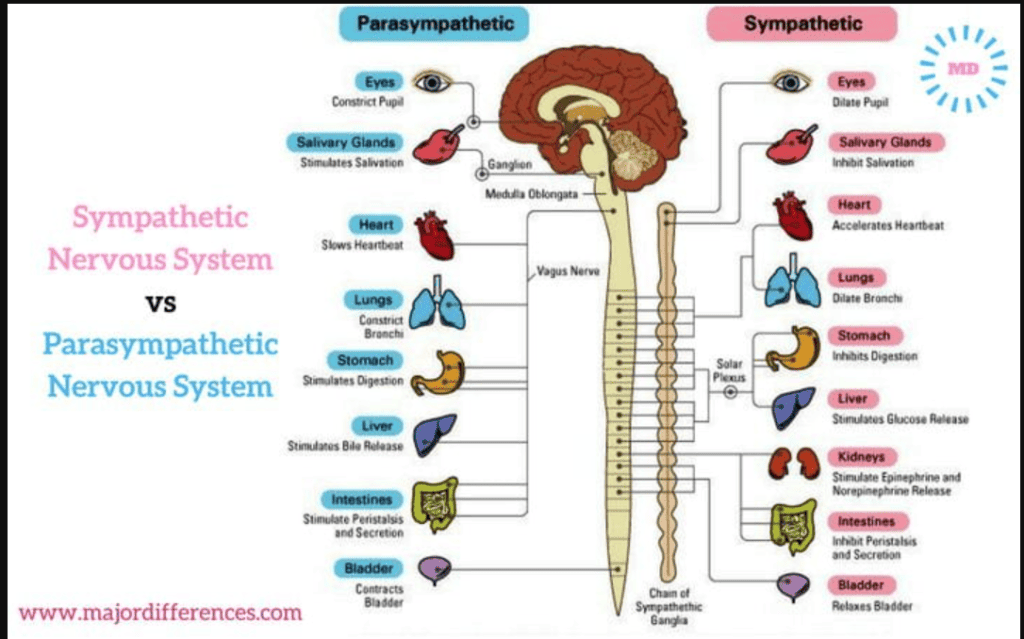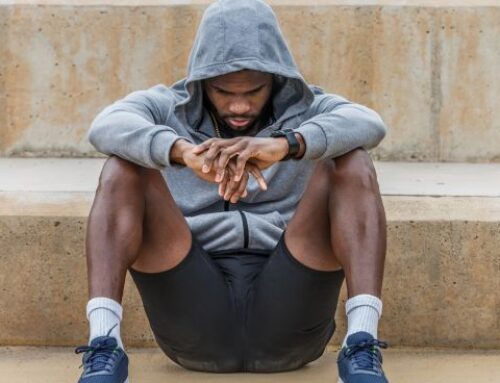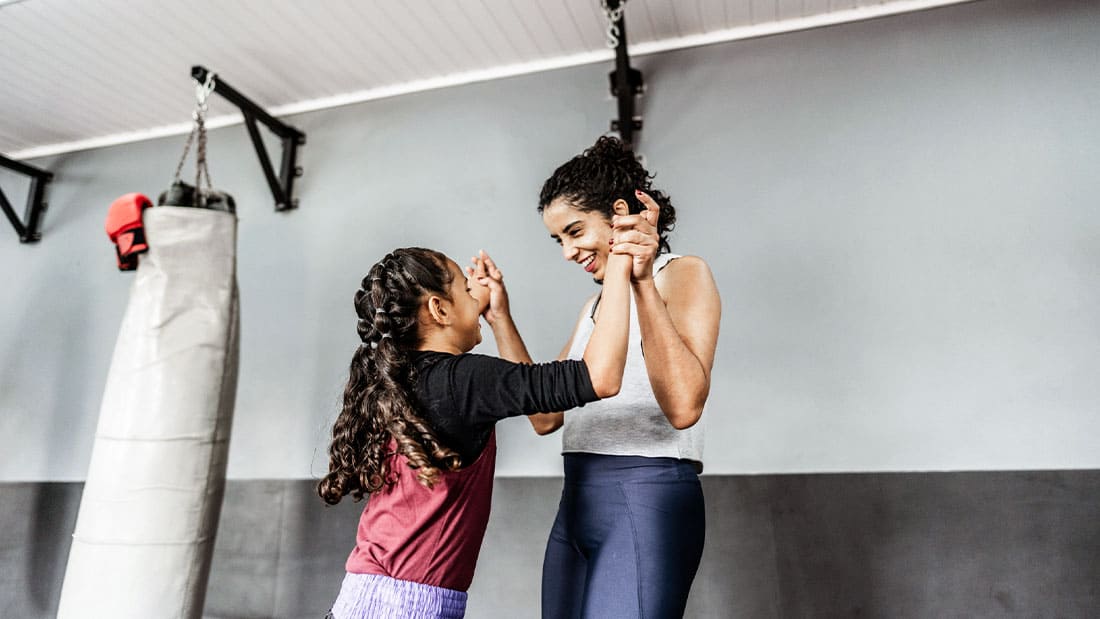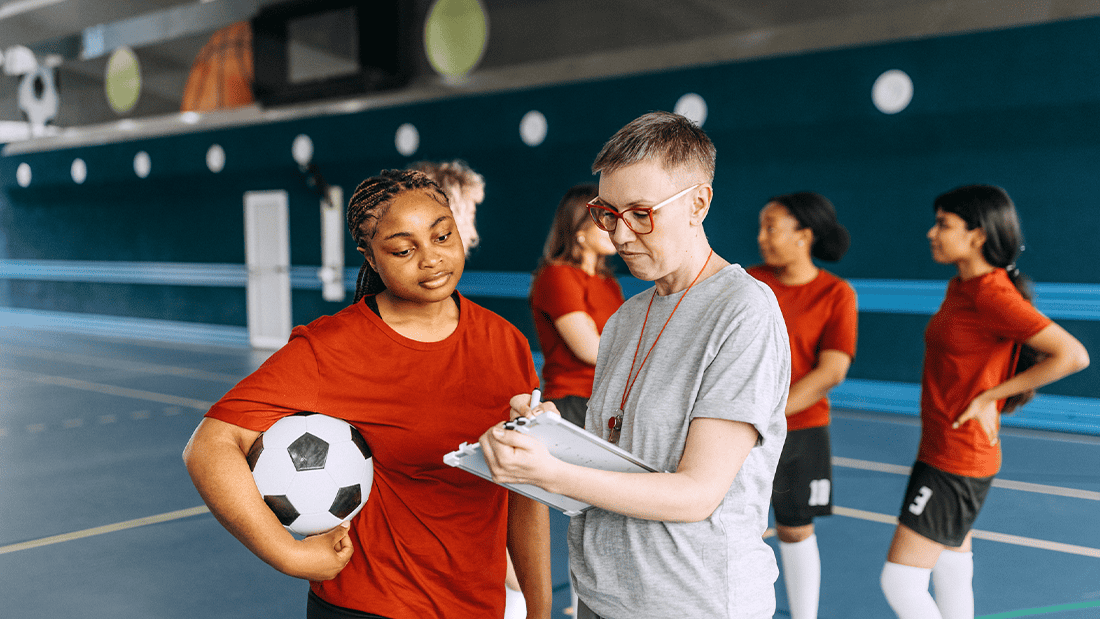Beginner Meditation For Athletes
Looking for a breath of fresh air? Look no further than your mind and your breath. Both are more powerful than you realize.
For instance, our nervous system can be in a parasympathetic state or a sympathetic state. A parasympathetic state is when we are calm, or peaceful (remember peaceful for parasympathetic). A sympathetic state is when our nervous system is sped up, like when we have a big game, a difficult test, or are about to be thrown into a water tank full of sharks (remember sped up for sympathetic). Your sympathetic state is your physiological reaction to stress. This diagram from Penn State shows some of the physiological differences between each state:
The sympathetic state and stress both get a bad reputation, but we need them for survival. We need to be stressed if we are going to be thrown into a water tank full of sharks because staying calm in our parasympathetic state will not help us survive. However, if our sympathetic state takes over and we panic, that will not help us survive either.
The magic happens when we can control our stress and our sympathetic state, rather than have them control us. A powerful way to stay in control of our sympathetic state, and our mental and emotional states, is by breathing and/or being aware of our thoughts. And just like we train our sports skills, we can train our breath and our mind.
It is important to note that developing a meditation or mindfulness practice is not a one-and-done thing. And yes, there is a difference between mindfulness and meditation. I include a chart to help differentiate at the bottom of this article, but the difference is not too important for this article. What is important is that you start to do either.
For now, I will say that mindfulness is being aware of your thoughts, without judgment. Meditation is more of a practice. Often, when we hear “meditation,” we think of monks sitting a certain way in a certain place. It doesn’t have to be. There are no rules to meditation or mindfulness. There are certain practices that have rules, but your practice does not need rules. It can if you want it to.
Meditation and/or mindfulness will help you excel in your sport because you will be able to stay calm and composed under pressure while your sympathetic state is speeding up. As a result, you will perform better. A bonus is that these practices will help you bring your sympathetic state down to parasympathetic when you get anxious or flustered throughout the day.
The Research
I did an experiment while gathering research for this article. To play devil’s advocate, I typed into Google, “Is mindfulness for athletes a real thing?” I did not find one article that said it wasn’t real or something that shouldn’t be taken seriously. All of the articles that came up were in support of mindfulness for athletes. In fact, the first article that pops up, The Magic Of Mindfulness in Sport, says that it is important to develop mindfulness practices now so that they can help us when we are under pressure.
In a more supportive and scientific search, I read a study titled, Instantaneous effects of mindfulness meditation on tennis return performance in elite junior athletes completing an implicitly sequenced serve return task. This study concluded that having 1 mindfulness practice before performance won’t really do anything, and emphasizes developing a mindfulness meditation practice now. The ability to control our breath and our physiological, as well as mental and emotional states, take training. That’s why a great new year’s resolution is to start developing this habit now, which we will get to shortly.
Another study titled, The Relationship between Mindfulness Practices and the Psychological State and Performance of Kyokushin Karate Athletes looked at karate athletes. Of the 371 high-level karate participants who have been practicing the sport for over 11 years, 84 of them self-reported that they have a meditation practice. And guess what? Those 84 performed better.
Key points in this study include, “there was a positive influence of meditation on athletic performance…we can conclude that mindfulness practices are related to athletes’ higher performance and better psycho-emotional state.” The researchers also wrote that “meditation before competition helps athletes to calm internal stimuli in this model.” For athletes with a regular meditation practice, using meditation before competing helped those athletes use their sympathetic state to their advantage.
I also want to point out that the article mentioned relationships such as, “when mindfulness is higher, athletes’ emotional state is better.” This study used a questionnaire and found that athletes who have a regular mindfulness meditation practice, have less anxiety and depression as well.
One more study before I go into actionable ways to start your own meditative practice is titled, Mindfulness Training Enhances Endurance Performance and Executive Functions in Athletes: An Event-Related Potential Study.
Athletes involved in this study participated in two 30-minute mindful sessions for 5 weeks and were strongly encouraged to practice mindfulness every day on their own for 15-30 minutes. Participants had no prior mindfulness practices. Results showed that mindfulness levels increased in the athletes who participated in the 30-minute sessions versus athletes who did not. Results also showed that there was a longer exhaustion duration in the mindful athletes (taken from a VO2 max test). And, in a certain drill, response time was not different, but accuracy was.
The Actionable Part
In the above studies, researchers used certain mindfulness meditation methods to give participants an intervention. I provide many different mindful and meditation options below, possibly to the point of overwhelm. Therefore, I challenge you to pick one to do each day for a week. After that, choose your favorite and do that one every day for a week. On week three, feel free to keep it up, or rotate. By week four, maybe we developed a habit. Or do it another way that works for you. Remember, there are no rules for mindfulness or meditation.
And remember that just like practicing your sport, you have to learn the basic skills first. Once you become comfortable with basic skills, then you can practice doing them under pressure. If you’re not doing them regularly, you won’t even think to do them under pressure. Here are some different methods:
- Set a timer for one minute and…
- Pay attention to everything you hear
- Or concentrate all of your attention and focus on your breath going in through the nose and out through the mouth
- Or be aware (mindful) of your thoughts – just note what they are, and accept them without judgment. Another way to think about this is to imagine your thoughts floating across your mind like clouds in the sky. Don’t attach, don’t judge. Just be.
- Count 10 breaths (in+out=1), and back down
- Breathe in for a count of 4, hold for a count of 7, and breathe out for a count of 8. Take 4-6 breaths like this here is why this one works and what is does
- Take 6 slow, deep breaths.
- You can do this throughout the day, and/or you can try to do this whenever you are changing tasks like from school to practice, or even in between classes. Why 6? Because 6 breaths per minute will cause physiological effects of the parasympathetic state.
- The Wim Hof Method Wim Hof also has a quick breathe method that gives you energy rather than calms you – Power Breaths
- A grounding exercise getting all your senses involved: 5, 4, 3, 2, 1
- Observe 5 things you see
- Observe 4 things you hear
- Observe 3 things you feel
- Observe 2 things you smell
- Observe 1 thing you taste
- Grab a pen and paper (NOT your phone), set a timer for one minute or more (okay to use your phone for the timer) and write down any and all thoughts that pop up without opening your eyes
- Since you can’t open your eyes, you will write your thoughts down blindly. If you can read them afterward, great. If not, they were probably not that important anyway, and now you got them out of your head and onto paper. You’re welcome.
- Visualization
- Set a timer for however long you want and think about what the perfect game will look like
- Or the perfect day
- Or something going wrong, and how you will react and adapt
- Nasal Breathing – here is an in-depth article on nasal breathing from Simply Faster
- Color
- Set a timer for as long as you’d like.
- As you breathe in, think about filling your body with pure white, and breathing out black negativity and toxicity
- Sieve
- Set a timer for as long as you’d like
- Imagine the negative, toxic energy being shaken out of you, like a sieve. You can even shake or sway a bit as you do this.
- Youtube a guided meditation, or download an app like Calm or Headspace.
As you practice these, please know that your mind is going to wander. That is okay. That is normal. When it does, gently refocus rather than being hard on yourself because your mind wanders. I struggle with this, we all do. The point is to stick with it rather than throw in the towel and give up. Even if you have to refocus 100 times in one minute, it’s okay.
Remember, just like mastering your sport, developing basic mindful meditation takes consistency and patience. Start to build that consistency now. Over time, you will be able to use mindful meditation under pressure and have more control of your sympathetic state so you can perform better.
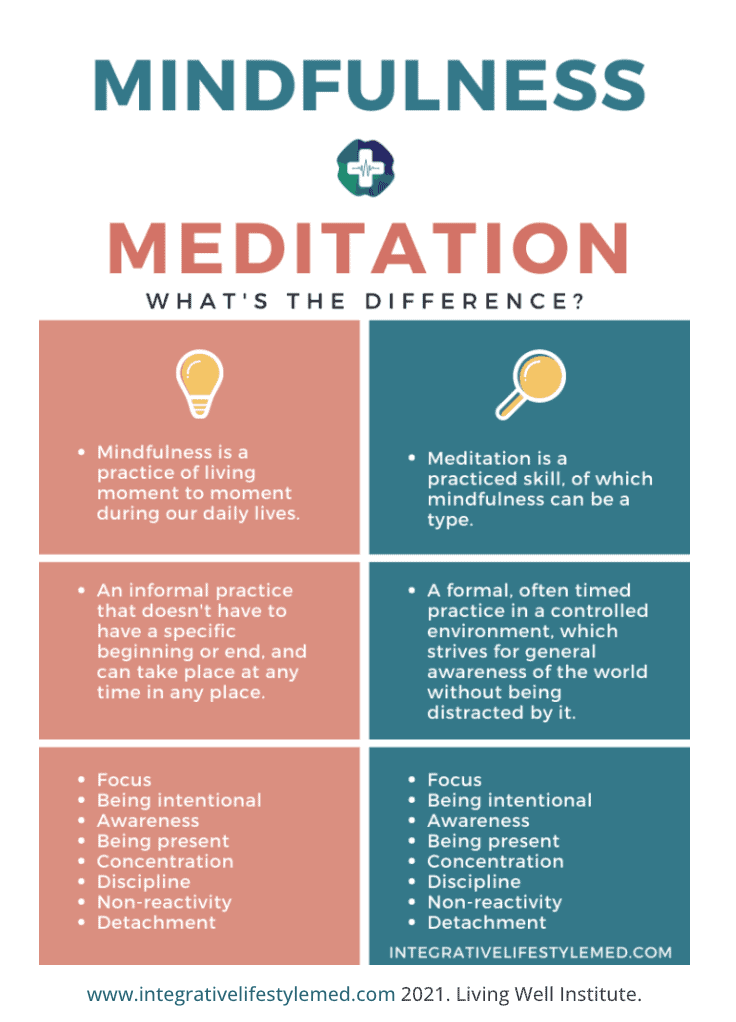
RECOMMENDED FOR YOU
MOST POPULAR
Beginner Meditation For Athletes
Looking for a breath of fresh air? Look no further than your mind and your breath. Both are more powerful than you realize.
For instance, our nervous system can be in a parasympathetic state or a sympathetic state. A parasympathetic state is when we are calm, or peaceful (remember peaceful for parasympathetic). A sympathetic state is when our nervous system is sped up, like when we have a big game, a difficult test, or are about to be thrown into a water tank full of sharks (remember sped up for sympathetic). Your sympathetic state is your physiological reaction to stress. This diagram from Penn State shows some of the physiological differences between each state:
The sympathetic state and stress both get a bad reputation, but we need them for survival. We need to be stressed if we are going to be thrown into a water tank full of sharks because staying calm in our parasympathetic state will not help us survive. However, if our sympathetic state takes over and we panic, that will not help us survive either.
The magic happens when we can control our stress and our sympathetic state, rather than have them control us. A powerful way to stay in control of our sympathetic state, and our mental and emotional states, is by breathing and/or being aware of our thoughts. And just like we train our sports skills, we can train our breath and our mind.
It is important to note that developing a meditation or mindfulness practice is not a one-and-done thing. And yes, there is a difference between mindfulness and meditation. I include a chart to help differentiate at the bottom of this article, but the difference is not too important for this article. What is important is that you start to do either.
For now, I will say that mindfulness is being aware of your thoughts, without judgment. Meditation is more of a practice. Often, when we hear “meditation,” we think of monks sitting a certain way in a certain place. It doesn’t have to be. There are no rules to meditation or mindfulness. There are certain practices that have rules, but your practice does not need rules. It can if you want it to.
Meditation and/or mindfulness will help you excel in your sport because you will be able to stay calm and composed under pressure while your sympathetic state is speeding up. As a result, you will perform better. A bonus is that these practices will help you bring your sympathetic state down to parasympathetic when you get anxious or flustered throughout the day.
The Research
I did an experiment while gathering research for this article. To play devil’s advocate, I typed into Google, “Is mindfulness for athletes a real thing?” I did not find one article that said it wasn’t real or something that shouldn’t be taken seriously. All of the articles that came up were in support of mindfulness for athletes. In fact, the first article that pops up, The Magic Of Mindfulness in Sport, says that it is important to develop mindfulness practices now so that they can help us when we are under pressure.
In a more supportive and scientific search, I read a study titled, Instantaneous effects of mindfulness meditation on tennis return performance in elite junior athletes completing an implicitly sequenced serve return task. This study concluded that having 1 mindfulness practice before performance won’t really do anything, and emphasizes developing a mindfulness meditation practice now. The ability to control our breath and our physiological, as well as mental and emotional states, take training. That’s why a great new year’s resolution is to start developing this habit now, which we will get to shortly.
Another study titled, The Relationship between Mindfulness Practices and the Psychological State and Performance of Kyokushin Karate Athletes looked at karate athletes. Of the 371 high-level karate participants who have been practicing the sport for over 11 years, 84 of them self-reported that they have a meditation practice. And guess what? Those 84 performed better.
Key points in this study include, “there was a positive influence of meditation on athletic performance…we can conclude that mindfulness practices are related to athletes’ higher performance and better psycho-emotional state.” The researchers also wrote that “meditation before competition helps athletes to calm internal stimuli in this model.” For athletes with a regular meditation practice, using meditation before competing helped those athletes use their sympathetic state to their advantage.
I also want to point out that the article mentioned relationships such as, “when mindfulness is higher, athletes’ emotional state is better.” This study used a questionnaire and found that athletes who have a regular mindfulness meditation practice, have less anxiety and depression as well.
One more study before I go into actionable ways to start your own meditative practice is titled, Mindfulness Training Enhances Endurance Performance and Executive Functions in Athletes: An Event-Related Potential Study.
Athletes involved in this study participated in two 30-minute mindful sessions for 5 weeks and were strongly encouraged to practice mindfulness every day on their own for 15-30 minutes. Participants had no prior mindfulness practices. Results showed that mindfulness levels increased in the athletes who participated in the 30-minute sessions versus athletes who did not. Results also showed that there was a longer exhaustion duration in the mindful athletes (taken from a VO2 max test). And, in a certain drill, response time was not different, but accuracy was.
The Actionable Part
In the above studies, researchers used certain mindfulness meditation methods to give participants an intervention. I provide many different mindful and meditation options below, possibly to the point of overwhelm. Therefore, I challenge you to pick one to do each day for a week. After that, choose your favorite and do that one every day for a week. On week three, feel free to keep it up, or rotate. By week four, maybe we developed a habit. Or do it another way that works for you. Remember, there are no rules for mindfulness or meditation.
And remember that just like practicing your sport, you have to learn the basic skills first. Once you become comfortable with basic skills, then you can practice doing them under pressure. If you’re not doing them regularly, you won’t even think to do them under pressure. Here are some different methods:
- Set a timer for one minute and…
- Pay attention to everything you hear
- Or concentrate all of your attention and focus on your breath going in through the nose and out through the mouth
- Or be aware (mindful) of your thoughts – just note what they are, and accept them without judgment. Another way to think about this is to imagine your thoughts floating across your mind like clouds in the sky. Don’t attach, don’t judge. Just be.
- Count 10 breaths (in+out=1), and back down
- Breathe in for a count of 4, hold for a count of 7, and breathe out for a count of 8. Take 4-6 breaths like this here is why this one works and what is does
- Take 6 slow, deep breaths.
- You can do this throughout the day, and/or you can try to do this whenever you are changing tasks like from school to practice, or even in between classes. Why 6? Because 6 breaths per minute will cause physiological effects of the parasympathetic state.
- The Wim Hof Method Wim Hof also has a quick breathe method that gives you energy rather than calms you – Power Breaths
- A grounding exercise getting all your senses involved: 5, 4, 3, 2, 1
- Observe 5 things you see
- Observe 4 things you hear
- Observe 3 things you feel
- Observe 2 things you smell
- Observe 1 thing you taste
- Grab a pen and paper (NOT your phone), set a timer for one minute or more (okay to use your phone for the timer) and write down any and all thoughts that pop up without opening your eyes
- Since you can’t open your eyes, you will write your thoughts down blindly. If you can read them afterward, great. If not, they were probably not that important anyway, and now you got them out of your head and onto paper. You’re welcome.
- Visualization
- Set a timer for however long you want and think about what the perfect game will look like
- Or the perfect day
- Or something going wrong, and how you will react and adapt
- Nasal Breathing – here is an in-depth article on nasal breathing from Simply Faster
- Color
- Set a timer for as long as you’d like.
- As you breathe in, think about filling your body with pure white, and breathing out black negativity and toxicity
- Sieve
- Set a timer for as long as you’d like
- Imagine the negative, toxic energy being shaken out of you, like a sieve. You can even shake or sway a bit as you do this.
- Youtube a guided meditation, or download an app like Calm or Headspace.
As you practice these, please know that your mind is going to wander. That is okay. That is normal. When it does, gently refocus rather than being hard on yourself because your mind wanders. I struggle with this, we all do. The point is to stick with it rather than throw in the towel and give up. Even if you have to refocus 100 times in one minute, it’s okay.
Remember, just like mastering your sport, developing basic mindful meditation takes consistency and patience. Start to build that consistency now. Over time, you will be able to use mindful meditation under pressure and have more control of your sympathetic state so you can perform better.


